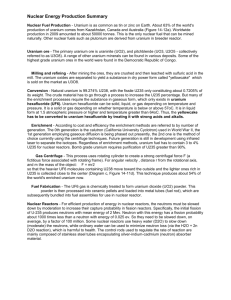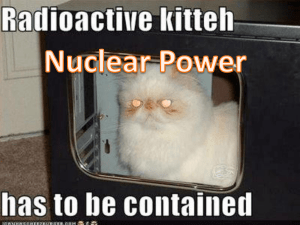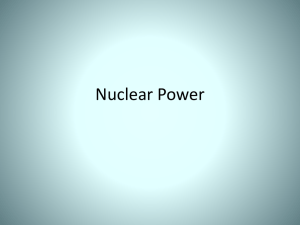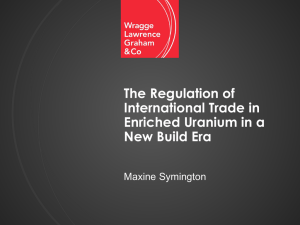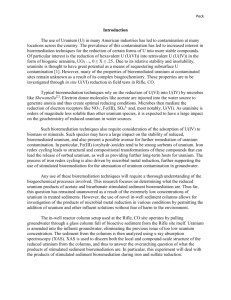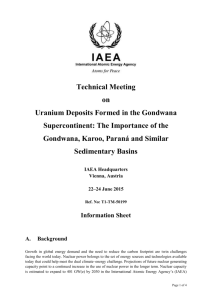View Slides - Arlington Technology Association
advertisement
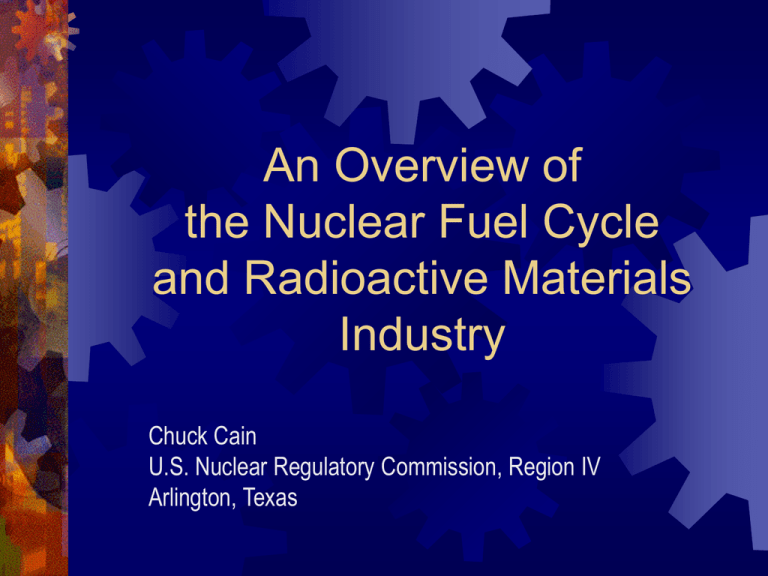
An Overview of the Nuclear Fuel Cycle and Radioactive Materials Industry Chuck Cain U.S. Nuclear Regulatory Commission, Region IV Arlington, Texas Implementing Legislation Atomic Energy Act of 1954 established the Atomic Energy Commission (AEC) Energy Reorganization Act of 1974 separated the peaceful uses regulatory function from the weapons function established the NRC weapons function eventually included in Department of Energy (DOE) Energy Policy Act of 2005 Authorizes NRC to regulate naturally occurring material and acceleratorproduced material Agreement States These are States that have agreements with NRC to regulate radioactive materials within their borders (except reactors) All States in NRC Region IV are Agreement States except Montana, Wyoming, South Dakota, Idaho, Alaska, and Hawaii Agreement State Map Since 9/11… …particular attention is paid to security and not only safety (user qualification and equipment) Uranium Mining and Milling Mining by conventional methods or by In-situ leaching Ore is < 1% uranium Mill extracts uranium from ore; rest is tailings Mill product is uranium oxide (known as yellowcake) and is shipped in 55-gallon drums The Sweetwater Mine & Mill (Wyoming) Atlas Minerals on Colorado River near Moab, UT Typical in situ Leach Well Field TYPIC AL SOLU TIO N FLOW PATTERN S LE GEN D IN JE C T IO N W E L L P R O D U C T IO N W E L L E X P E C T E D F LO W P A T TE R N 0 60 ' 12 0' 18 0' 24 0' Yellowcake belt dryer Yellowcake Product Yellowcake is packaged into 55-gallon drums and prepared for shipment. Facts About Yellowcake Can be held in hands without harm. A drum of yellowcake weighs about 1,000 pounds. Natural uranium contains mostly uranium-238 (99.3%). We want the U-235 which is only 0.7% of natural uranium. Enriched Uranium The next challenge is to enrich the uranium (increase the proportion of U-235) Enrichment plants usually work by gaseous diffusion; therefore, the uranium must be converted to a gas. Conversion Plants Produce UF6 Yellowcake can be converted to uranium hexafluoride which has a triple point of 147° F Honeywell, Metropolis, IL Sequoyah Fuels, Gore, OK (closed) Enrichment Plants Since an atom of U-238 is larger than an atom of U-235, the atoms can be filtered at a gaseous diffusion enrichment plant. Uranium must be enriched to ~10% to make nuclear fuel for a reactor. Oak Ridge Paducah Gaseous Diffusion Plant UF6 is stored in cylinders. This one is rated at 14 tons. Depleted Uranium Depleted uranium is a waste product of the enrichment process. Depleted uranium is “depleted” in U-235 (less than 0.7% U-235). DU can be used for purposes where a heavy mass is needed, such as military projectiles. New Technologies Gas centrifuge Louisiana Energy Services Areva Laser separation Fuel Fabrication The enriched UF6 is converted to a powdered chemical form and made into fuel pellets. Spent Fuel Eventually fuel elements become “poisoned” during the fission process and need to be replaced. This is considered “high-level” waste. There is still much good U-235 left in spent nuclear fuel. The “poisons” (byproduct material) produced during the fission process are high-energy gamma emitters. Spent fuel Spent fuel stored in a fuel pool What’s next for spent fuel? Several store options at reactor site in pool store at site in Independent Spent Fuel Storage Installation (ISFSI) burial at geological repository reprocess (recycle) to separate the remaining good uranium from the waste Arkansas Nuclear One ISFSI Rancho Seco ISFSI Yucca Mountain, Nevada Also, Low-Level Waste Contaminated or potentially contaminated items such as protective clothing, building materials, tools, etc. Burial at licensed disposal site such as EnergySolutions (UT or SC), U.S. Ecology (WA) Quantity of Radioactive Material Unit of measurement - curies or becquerels Half-Life Time it takes for half of a radioactive material to decay Cobalt-60, 5 years Uranium, millions of years Some materials decay with a half-life in minutes or seconds, such as those for medical use. Dose to Radiation Units of rems or sieverts Radiation worker limit is 5 rems Limit for a member of the public is 100 millirems Uses of Radioactive Materials Kinds of Licenses Specific General (e.g., tritium exit signs) Exempt (e.g., smoke alarms) “Materials” Applications Medical (diagnosis, therapy) Academic Industrial (radiography, gauges, petroleum industry) Industrial Radiography Radiography “cameras” 100 curies of iridium-192 in “pigtail” Nuclear Gauges Petroleum Well Logging Radioactive materials are installed in tools to characterize producing zones deep underground Injury to hands caused by radiation exposure from radiography source Day 14 – Medical attention first received; swelling, tenderness, skin darkening and some blistering is evident. Estimated exposure 22K – 30K rems. Day 19 – Extensive blistering is apparent. Day 24 – Blisters are breaking and dead skin is sloughing off, exposing raw tissue underneath. Day 27 – Areas of obvious injury continue to grow larger, with no evidence of healing. Increasing pain in damaged areas. Day 56 – Pain has increased until damaged tissues can no longer be exposed to air. Decision to perform skin grafts. Day 102 – Extensive skin grafting complete. Deep tissue injury continues. 5 years – Loss of fingers; hands sensitive to heat and cold; additional amputations may be required. Another Radiation Exposure Case Warehouse worker finds radiography source on floor after radiographer leaves Worker places source pigtail in back pocket and asks secretary to call radiography company to come pick it up 100 curies of iridium-192 in “pigtail” Radioactive Materials Not Licensed Certain jewelry items Fiesta ware Coleman lantern mantles Smoke detectors Remaining Questions?


